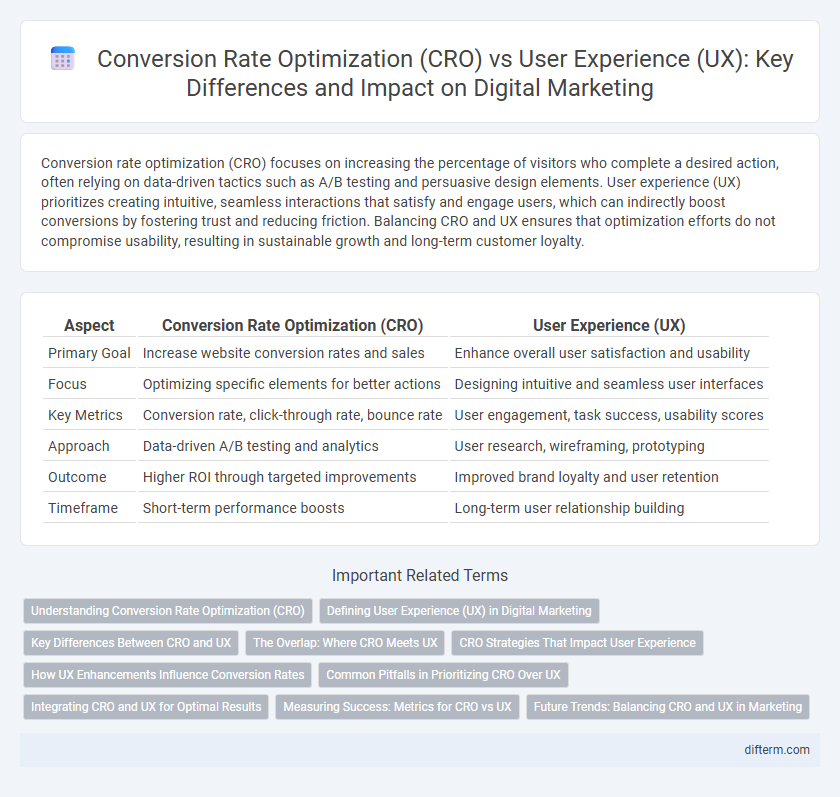Conversion rate optimization (CRO) focuses on increasing the percentage of visitors who complete a desired action, often relying on data-driven tactics such as A/B testing and persuasive design elements. User experience (UX) prioritizes creating intuitive, seamless interactions that satisfy and engage users, which can indirectly boost conversions by fostering trust and reducing friction. Balancing CRO and UX ensures that optimization efforts do not compromise usability, resulting in sustainable growth and long-term customer loyalty.
Table of Comparison
| Aspect | Conversion Rate Optimization (CRO) | User Experience (UX) |
|---|---|---|
| Primary Goal | Increase website conversion rates and sales | Enhance overall user satisfaction and usability |
| Focus | Optimizing specific elements for better actions | Designing intuitive and seamless user interfaces |
| Key Metrics | Conversion rate, click-through rate, bounce rate | User engagement, task success, usability scores |
| Approach | Data-driven A/B testing and analytics | User research, wireframing, prototyping |
| Outcome | Higher ROI through targeted improvements | Improved brand loyalty and user retention |
| Timeframe | Short-term performance boosts | Long-term user relationship building |
Understanding Conversion Rate Optimization (CRO)
Conversion Rate Optimization (CRO) focuses on systematically improving a website or landing page to increase the percentage of visitors who complete desired actions such as purchases, sign-ups, or downloads. CRO involves data-driven strategies, including A/B testing, heatmaps, and user behavior analysis, to identify barriers and optimize the conversion funnel. Prioritizing CRO enhances marketing efficiency by maximizing ROI and turning more traffic into measurable business outcomes.
Defining User Experience (UX) in Digital Marketing
User Experience (UX) in digital marketing encompasses the overall interaction between a user and a brand's digital platforms, emphasizing ease of navigation, responsive design, and personalized content delivery. Optimizing UX focuses on reducing friction points, enhancing site speed, and ensuring intuitive interface layouts to boost engagement and satisfaction. Effective UX design directly impacts conversion rates by creating seamless, enjoyable experiences that guide users toward desired actions.
Key Differences Between CRO and UX
Conversion Rate Optimization (CRO) focuses on increasing the percentage of website visitors who complete desired actions, such as purchases or sign-ups, using data-driven techniques like A/B testing and analytics. User Experience (UX) emphasizes enhancing overall user satisfaction by improving website usability, accessibility, and navigation through qualitative research and user-centered design. While CRO targets conversion metrics directly, UX aims to create a seamless and intuitive interaction that indirectly boosts conversion rates by addressing user needs and pain points.
The Overlap: Where CRO Meets UX
Conversion rate optimization (CRO) and user experience (UX) intersect in enhancing website performance by aligning user needs with business goals, ensuring seamless navigation and clear calls-to-action. Effective CRO strategies integrate UX principles such as intuitive design, fast load times, and personalized content, resulting in higher engagement and increased conversion rates. Understanding user behavior through analytics enables marketers to create targeted optimizations that improve both the usability and profitability of digital assets.
CRO Strategies That Impact User Experience
Conversion rate optimization (CRO) strategies that prioritize seamless navigation, fast-loading pages, and clear call-to-action buttons significantly enhance user experience (UX) by reducing friction and boosting engagement. Implementing A/B testing on landing pages helps identify design elements that resonate with users, leading to higher conversion rates without compromising usability. Personalization techniques such as targeted content and dynamic offers improve relevance, creating a more satisfying UX while driving measurable increases in sales and lead generation.
How UX Enhancements Influence Conversion Rates
UX enhancements streamline navigation, reduce friction, and create intuitive interfaces that keep users engaged, directly boosting conversion rates by minimizing drop-offs. Improved loading times, clear calls-to-action, and mobile-friendly designs contribute to higher user satisfaction, which correlates with increased sales and sign-ups. Data from case studies show that websites with optimized UX can see conversion rate increases of up to 200%, demonstrating the critical impact of user-centric design on marketing success.
Common Pitfalls in Prioritizing CRO Over UX
Prioritizing Conversion Rate Optimization (CRO) over User Experience (UX) often leads to intrusive pop-ups, misleading CTAs, and aggressive sales tactics that frustrate users and increase bounce rates. Neglecting UX fundamentals in favor of short-term conversions can damage brand trust and reduce customer lifetime value, undermining long-term growth. Balancing CRO strategies with seamless, intuitive design is essential to create sustained engagement and maximize revenue.
Integrating CRO and UX for Optimal Results
Integrating Conversion Rate Optimization (CRO) with User Experience (UX) enhances website effectiveness by aligning data-driven strategies with user-centric design principles. Prioritizing seamless navigation, fast loading times, and personalized content improves engagement while optimizing key conversion metrics such as click-through rates and lead generation. Leveraging A/B testing and UX research together ensures continuous enhancement of both user satisfaction and business outcomes.
Measuring Success: Metrics for CRO vs UX
Measuring success in Conversion Rate Optimization (CRO) revolves around quantitative metrics such as conversion rate, bounce rate, and average order value, which directly indicate the effectiveness of designed funnels and call-to-actions. In contrast, User Experience (UX) measurement emphasizes qualitative data including user satisfaction scores, task completion rates, and time-on-task, reflecting how intuitive and engaging the interface feels to users. Balancing both CRO and UX metrics provides a comprehensive view of performance, ensuring that optimization efforts not only drive conversions but also foster positive user interactions and loyalty.
Future Trends: Balancing CRO and UX in Marketing
Future trends in marketing emphasize the integration of Conversion Rate Optimization (CRO) and User Experience (UX) to create seamless, intuitive customer journeys that drive higher engagement and sales. Emerging technologies such as AI-driven personalization and predictive analytics enable marketers to tailor experiences that optimize conversion rates without compromising user satisfaction. Balancing CRO and UX will become critical as brands aim to foster long-term loyalty while maximizing immediate revenue through data-informed, user-centric strategies.
Conversion rate optimization (CRO) vs user experience (UX) Infographic

 difterm.com
difterm.com